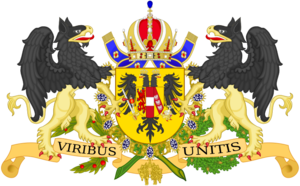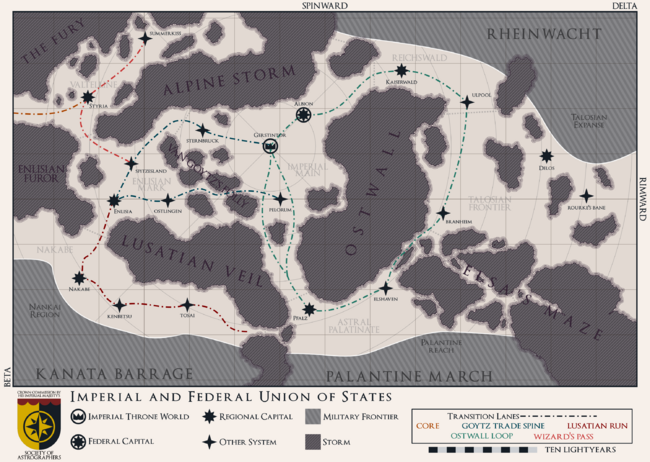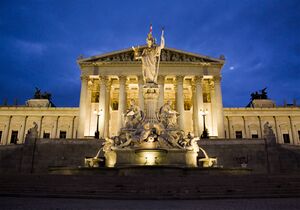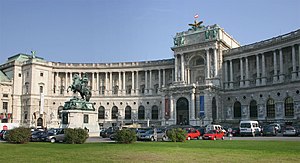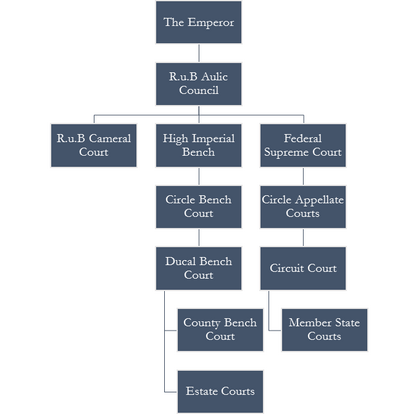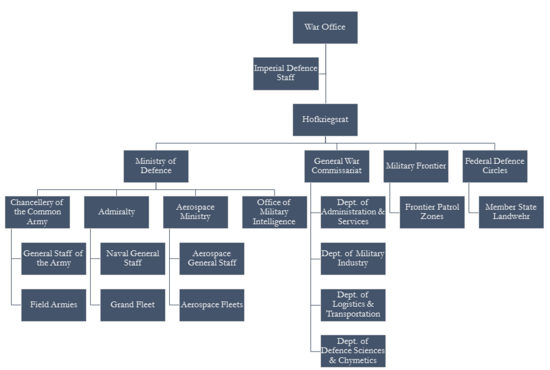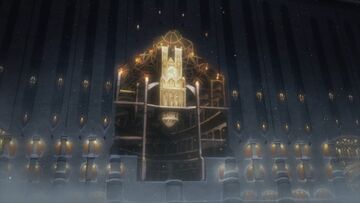Imperial and Federal Union
Imperial and Federal Union of States Reichs und Bundes Unionen der Staten | |
|---|---|
Motto: AEIOU | |
Anthem: Kaiserhymne | |
| Capital | Vienna (Imperial) Auxminster (Federal) |
| Largest city | Katensbruck, New Carinthia |
| Official languages | German, English |
| Demonym(s) | Imperial, Federal |
| Government | Constitutional Monarchical Federation |
• Emperor | Karl Franz II von Habsburg |
• Prime Minister | Lord Charles Lewis of Hawthorne |
| Establishment | |
• Declaration of the Union | 25 December, 548 P.L |
| Currency | Kroner (Kr) |
| Date format | dd-mm--yyy |
The Imperial and Federal Union of States (German: Reichs und Bundes Unionen der Staten), referred to in short hand as the RBUS, R.u.B, or Imperial Union, is an interstellar state within the the Aquila Cluster in the Beta Quadrant of the Milky Way Galaxy, controlling several dozen systems, along with a large number of space habitats, remote mining, research, and sensor stations, and minor colonies. The Imperial and Federal Union is a relative new comer on the galactic stage, and has recently engaged in a massive exploration and colonisation program designed to more accurately map the Aquila Cluster and beyond for continued expansion of the Union's holdings. However, this expansion has led to external and domestic friction over colonisation rights.
The Imperial and Federal Union of States developed from the inhabitants of the sleeper ships Tegethoff and Nelson, launched from the world of Old Terra in the Orion Arm of the Milky Way galaxy, towards systems with potential habitable worlds. Launched before the development of FTL travel, they were each filled with enough individuals to provide the genetic variety necessary to establish a successful colony. Unfortunately, contact was lost with Old Terra prior to the sleeper ships' arrival at their destination for unknown reasons. Contact with Old Terra has never been re-established. Dates in the Imperial & Federal Union are based on years 'Post Landing' from the date of the Tegethoff landing in the system of Gerstintor. The Nelson landed on the nearby system of Hawthorne in 51 P.L. Contact was quickly established between the two, and development of both systems began.
Over the subsequent centuries, the initial settlements developed themselves and expanded their presence in the Aquila Cluster, settling additional systems. Contact was never re-established with Old Terra, though eventually contact was established with several other states in the cluster, some of which also had their origin in colony ships from other Old Terran cultures, while others were alien or unexplained in origin. The Imperial and Federal Union was formed in 548 P.L. as a union of both systems, and their colonies following the Fae War. Since then, the Imperial & Federal Union has engaged in a campaign of expansion and colonisation throughout the Aquila cluster, incorporating both Terran and alien states, while coming into contact and establishing relationships with others.
Imperial Family
The current ruling family of the Imperial and Federal Union of States is the House of Habsburg. The population of the Tegethoff came mainly from the Holy Roman Empire on Old Terra, which was ruled by the House of Habsburg. Several members of this family--along with several other noble families--were on board the colony ship. An aristocratic-monarchical system of government was soon established for the colony, with Archduke Albrecht claiming the title of both Viceroy and Archduke of Gerstintor in 5 P.L. Once it became clear that contact with Old Terra could not be re-established under the reign of the Archduke Francis I in 101 P.L., Francis declared himself Emperor of Gerstintor and Her Dependencies. Upon formation of the Imperial & Federal Union, the Emperors of Gerstintor became Emperor of the Union as a whole. The House of Habsburg has intermarried with many of the other noble families within the Union as a whole, as well as with other noble and royal houses within the Aquila cluster.
The current Emperor of the Union is Karl Franz II (b. 1057, r. 1104). At present, Karl Franz II is married to the Princess Anne of Albion, and they have four children at the present time. The Crown Princess, Archduchess Maria Sophia (b.1076) is the current heir to the throne as King of the Romans. Their other children are the Archduchess Hannah (b. 1085), the Archduke Rudolph (b. 1090) and the Archduke Hans (b. 1096).
The full title of the Emperor is as follows:
His Imperial Majesty Karl Franz, of the Princely House of Habsburg, Second of His Name, by the Grace of God Rightful Sovereign and Emperor of the Holy Imperial Union and her Honoured Federal States, forever August, duly elected President of the Federal Diet, Archduke of Gerstintor and Lord of the Lands Represented in the Imperial Council, Lord High Justicar of the Courts, Primus Inter Pares amongst the Most Holy and Noble Estates, Chair of the Imperial and Federal Privy Council, Protector of the Realm, Grand Master of the Knightly Order of the Imperial Fleece, Lord High Marshal, Protector of the Most Holy Terran Church, and presumptive Holy Roman Emperor, Archduke of Austria, and King of Iberia until Terra Doth Come Again.
Astrography
Main Article: Worlds of the Imperial and Federal Union
The Imperial and Federal Union of States resides within the Aquila Cluster of the Milky Way Galaxy, and controls a significant number of systems, including several dozen heavily populated and industrialised systems and a large number of less developed ones. Beyond these, there are an almost unknown number of remote colonies, mining sites, research stations, and other installations that simply do not have the population or scale necessary to be organised as a member state. At present there are forty five recognised systems, along with several dozen frontier worlds without self rule. In addition, there are a multitude of space habitats, remote mining, research, or sensor stations, and assorted minor colonies, however these are not usually marked on maps of the Imperial & Federal Union, and have extremely limited populations. These systems can generally be divided into several regions: the Imperial Main, the Valtelline, the Enlisian Mark, the Astral Palatinate, the Reichswald, Nakabe, and the Talosian Frontier.
Imperial Main
The Imperial Main makes up the most populous, wealthiest, and most productive systems in the Imperial & Federal Union. They make up a disproportionate portion of the Union's economic and political power, and--effectively--rule over the rest of the Union. The systems here are home to not only the most important crownlands, but the most powerful member states as well. The Imperial Main is astrographically defined by the Ostwall, Alpine, Lusation, and von Goytz Clouds, which create a series of transition choke points: the Enlis Corridor, the Latin Corridor, and the Alpine Pass. These corridors have subsequently made the systems on either side of the corridor quite wealthy from trade, and major concentrations of economic, political, and military assets.
The key systems of the Imperial Main include the Imperial capital of Gerstintor and the Federal capital of Albion. The Imperial Main also includes the major systems of New Terra, Sternbruck, Havordshire, Hawthorne, Ostbruck, and Pelorum. The largest industry within the Imperial Main is trade, financial services, and light manufacturing. Heavy industry is not as heavily concentrated within the Imperial Main as one would expect, with most Imperial Main industry being of the high-tech variety, benefiting from the concentrations of capital and skilled labour in the area. Key manufactured items include electronic items of all kinds and artificial intelligence matrices. Most of the largest trade, financial, and other corporations within the Imperial and Federal Union are headquartered within the Imperial Main, and many of the Imperial nobility strive to maintain some family holdings within the Imperial Main, as such holdings make acquiring a position within the Imperial Court and high levels of the bureaucracy much easier.
Valtelline
The Valtelline is a relatively undeveloped area of the Imperial & Federal Union, consisting of a narrow corridor that leads between the Alpine Storm and the impenetrable barrier of the Fury. Unlike the other corridors that connect the Imperial Main to the rest of the Union, which are large, stable, and high speed, the Valtelline is marked by smaller persistent clouds and is characterised by a general slow speed and volume of travel. As a result, colonisation efforts directed down the Valtelline have been much slower than similar efforts aimed out of the Latin Corridor or Alpine Pass. The government of the Valtelline is concentrated on Styria, which remains distinct from the other Imperial Main systems by its focus on the manufacture of key colonial goods, along with refining resources from the Valtelline's wide array of extraction facilities.
Surrounded as it is by various clouds and other aetheric phenomenon, the worlds of the Valtelline are unusually rich in mineable chymetic condensations. Flanelite, orichalcum, phlogiston, and many others are mined in large quantities. Most impressive of these is the Tanhausertor Fountain, an apparently chymetic star which produces large amounts of chymetic condensations for harvest. As a result, the regional capital world of Styria has become a major centre of chymetic study, and plays host to the main campus of the Imperial & Federal Grand College of Chymetics.
Another important feature of the Valtelline is the recently established Deep Core Lane just beyond the cloud structures. The Deep Core Lane is unique amongst transition lanes, as it is more of a wormhole than a standard lane. The Deep Core Lane provides extremely rapid transit into the galactic Deep Core, but it has so far proven impossible to exit the lane before reaching its terminus. As the Deep Core Lane is a new discovery, it has not yet been fully developed, but heavy infrastructure development has begun in order to begin exploiting the resources of the area and the Deep Core. In a more general sense, the Valtelline is the gateway to further Imperial expansion into the Beta Quadrant and coreward.
Enlisian Mark
The Enlisian Mark is a key region of the Imperial & Federal Union. The Enlisian Corridor is one of the major links between the the Imperial Main and the Nakabe Prefecture, bypassing the large Lustatian Veil cloud, and is a key part of the Nakabe Run to the Beta Quadrant. The transition lanes that pass through the Enlis Corridor are among the fastest links in the whole of the Imperial & Federal Union, and have made the systems of the Corridor and Mark into some of the wealthiest trade hubs in the Union. The Mark consists of the Duchies of Enlisia, Ostlingen, and Spitzesland. While one of the smallest regions in terms of numbers of planets, he Enlisian Mark is the industrial heart of the Imperial & Federal Union, being well placed to benefit from both the resource extraction and basic refining activities of the Astral Palatinate and the high tech production and materials of the Core, along with the high speed Enlisian Transition Lane to facilitate rapid export of finished products. The high industrial output of the three major Enlisian systems have led them to be known as the Steel Triangle.
The three Enlisian Mark systems are heavily industrialised in all respects, with planetary and orbital infrastructure heavily developed for production of heavy, light, and orbital industrial goods. The orbital shipyards of Enlisia and Spitzesland in particular are among the most important industrial facilities within the entirety of the Imperial & Federal Union, while the resource processing and refining operations of Ostlingen supply the materials for the other systems and the Imperial Main. All three systems are majority member states, but play host to several major noble families who base their power on their control of key industries and facilities. Political intrigues in the Enlisian systems are common, but tend to be more subdued and financial when compared to the old feuds of the Imperial Main or the more brash attitudes of the Astral Palatinate and Reichswald.
Reichswald & Astral Palatinate
The Reichswald and Astral Palatinate are regions of the Imperial and Federal Union located beyond the Ostwall Cloud, and linked to the Imperial Main by the Alpine Pass and Latin Corridor respectively. The two regions have mostly been settled much more recently than the Imperial Main, and are often pejoratively called he Colonies by many in the Imperial Main. Although considered two regions, both share many characteristics.
Most of the systems in the Palatinate and Reichswald are less developed than the worlds of the Imperial Main or Enlisian Mark, and are the primary source of resources needed to fuel the industries of those more metropolitan regions. However, the systems of these two regions are some of the most diverse in the entirety of the Imperial and Federal Union. While many of the systems boast only a few cities, centred around mining or agriculture, others have grown specialised in their trade, and support powerful, diverse, and developed economies equal to those of the coreward worlds. Hochgarten is known for some of the lushest fields and finest wines in the Union, while Duskendale Primaris is often called the 'resort world' for the prevalence of its tourist industry.
The Reichswald also forms part of the R.u.B military frontier, and as such has been the site of significant activity by the R.u.B Wehrmacht. Politically, the regions are heavily dominated by member states, with the crownlands mainly located near and around the worlds of Kaiserwald, Hochgarten, and Pfalz, along with the corridors. The prevalence of member states has combined with a general sense of independence amongst the systems of the Reichswald and Astal Palatinate. While occasionally resentful over taxes and other demands from the core, the greatest source of tension comes from further expansion. The various capital worlds, along with the Imperial Main are often in fierce competition over trade and colonisation rights for newly discovered worlds. While this competition has never led to outright conflict, it has led to many angry confrontations in the Federal Diet, and a continual thorn in the side of the R.u.B government.
Nakabe
See also: Grand Prefecture of Nakabe
Nakabe is a unique area within the Imperial & Federal Union, as the entirety of the prefecture is ruled by one member state, the Grand Prefecture of Nakabe. Most member states only control a small portion of one world, or at most a single system, but the Nakabe Prefecture rules several system. Much like the Union itself, Nakabe was settled by a colony ship from another Old Terran State, in this case the Greater Pacific Co-Prosperity Sphere. However, the settlers of Nakabe eventually expanded beyond their landing world, and began settling others. First contact with the Grand Prefecture was made in 895 P.L. Initial relations between the Prefecture and the R.u.B Union were tense, with conflict often occurring over control of trade lanes to the burgeoning states further spinward and coreward into the Beta Quadrant. However, the Betan Economic Collapse caused severe damage to the Prefecture, and it was eventually included into the Union as a single member state, but with several unique privileges.
The admission of Nakabe into the R.u.B Union was a unique event, and the Grand Prefecture received a unique position within the R.u.B Union. The Grand Prefecture holds a veto vote within the Federal Diet, and also sends a permanent representative to the Imperial Council of State. The Prefectural government also carries a large amount of unofficial influence over general Imperial policy, with direct connections between the Prefecture and other aspects of the R.u.B government.
The Prefecture is utterly dominated by the system of Nakabe as an industrial, political, economic, and cultural centre. Many of the other systems of the Prefecture are little more than oversized mining colonies, but with populations that rival many other worlds in the Palatinate or Reichswald. As the primary support structure for the Kanata Barrage, the Prefecture is heavily militarised, with local forces fusing the R.u.B Wehrmacht and the Landwehr of the Grand Prefecture under one command in the Prefectural General Headquarters, which has a great deal of independence from the usual command structure of the R.u.B Wehrmacht.
The Talosian Frontier
The Talosian Frontier is located further rimward than the Astal Palatinate and the Reichswald, and represents the first holdings of the R.u.B Union outside of the Aquila Cluster in the open space of the Delta Quadrant. Only recently acquired by the Union as a result of the Frontier War, the Talosian Frontier is more developed than the Farlights, containing several major colony worlds--including some that rival worlds in the Palatinate and Reichswald in terms of development. However, the Talosian systems are restive, and much of the territory is near lawless, as remnants of the Delian Star League along with local insurgents operating as pirates amongst its transition lanes. Nonetheless, the Talosian Frontier is a ready source of new worlds for colonisation, and serves as an additional jumping off point for further expansion into the Delta Quadrant. This attention has made the Frontier a very attractive place for younger members of coreward Princely Houses, as well as commoners seeking to strike their fortune. Unrest further spinward into the Delta Quadrant has also made the Talosian Frontier a tempting home for refugees from beyond, and the Rheinwacht Line has integrated many of these refugees into the local structure of military frontier worlds, providing a ready made military force for the region.
Political Divisions
The Imperial and Federal Union of States is broken up into various sub units in line with its two part government structure. A territory under the rule of the Union will either be governed by the Federal or Imperial government, each of which provides a different sets of rights, privileges, and responsibilities for the territory. Regardless of the position though, each individual planetary system of the Imperial & Federal Union will receive oversight from an R.u.B commissioner, whom serves as a representative of the central government over the whole of the system. Certain systems may receive additional representatives for specific worlds, or even regions within a world if necessary.
Member States
Member States are the component pieces of the Federal government aspect of the Imperial & Federal Union. Each member state is effectively sovereign, except for the authority reserved to either the Federal or central government. So long as the member state observes the Imperial & Federal Contract and any relevant laws or edicts, the member state is allowed to do as it likes. This has resulted in great diversity amongst the various member states of the Union, with government types ranging from absolutist monarchies and aristocratic oligarchies to constitutional republics and democracies, and in size from city states to interplanetary entities. Existing foreign states are usually incorporated into the Union as a member state if so desired, provided they agree to and sign the Contract and Charter of Union and the stipulations wherein. As a result of this ease, the majority of the Union's territory is dominated by member states of various size, governments, and even species.
In line with the Contract and Charter of Union, a member state's only limitations on power are that it must not engage in relations with states not a part of the Imperial & Federal Union, that it must allow for the induction of its forces into the Kaiserliche Wehrmacht, that it must pay the Kontribution defence tax into the Imperial & Federal Court Treasury, and that it be subject to the laws of the Federal Diet and Courts. Beyond these requirements, a member state is generally free to act as it pleases. Member states are permitted to raise their own defence forces, but these forces are limited to operation within the member state's system. While these local defence forces do often result in tension between various member states--sometimes erupting into armed conflict--most disputes are effectively settled via the Federal or Aulic courts.
Crownlands
Crownlands are territories which are, directly or indirectly, owned by the Emperor, rather than a separate member state. These territories can be divided into noble estates, where the administration of the territory has been entrusted to a noble lord, and Erblande territories, where the Emperor retains direct control. The administration of these territories depends heavily on the precise nature of the relationship the territory has with the Emperor and the rest of the Imperial government.
Noble Estates
See also: Nobility of the Imperial & Federal Union
Noble Estates are parcels of land that the Emperor has enfeoffed with a Princely House. The enfeoffment grants the House a freehold over the land, in exchange for a promise to pay the Kontribution, and to enforce the Emperor's edicts upon the people. The responsibilities of the Princely Houses also include the provision of recruits to the Imperial & Federal Wehrmacht. In exchange for these promises, Princely Houses holding an enfeoffment directly from the Emperor have almost complete authority over their realms, bound only by Imperial Edict, and the constraints of the Contract and Charter of Union. They can enfeoff parts of their estate to lesser lords, creating effective hierarchies of nobles. In addition, by holding Imperial immediacy, the Princely Houses gain the right to stand for a seat on the Imperial Council. The Emperor can revoke an enfeoffment, but doing so generally requires the issuance of an Imperial Ban upon the Princely House holding the title to the estate.
In general, the Princely Houses are responsible for their own administration, though the exact extent of their independence is often heavily dependent on the precise nature of the enfeoffment statement held by the Princely House. In general, the Princely House does host an office of the various Imperial Chancelleries, which serve to ensure that the local lord properly fulfils their responsibilities to the Emperor under the turns of their enfeoffment. Interestingly, not all noble estates are granted to individual noble houses. Rather, some are granted as Imperial charters to cities or member states, which grants the same rights usually provided to an Imperial prince to the city itself, and its councillors.
Erblande
Erblande territories consist of areas ruled directly by the Emperor, without being enfeoffed to either a noble estate or a member state. These territories are administered directly by the Imperial State Chancellery, and are ruled quite differently from the Noble Estates. As a result of their direct rule by Imperial authorities, the Erblande territories are taxed directly by the Imperial government, but they do not pay the Kontribution, and often have special trading rights. This combines to make the Erblande territories some of the most prosperous in the Union. In addition, the Erblande territories provide much of the recruitment base for the Wehrmacht, but are also often some of the most heavily fortified and well defended areas in the Union. Erblande territories also often play host to offices of various R.u.B, Imperial, and Federal institutions, making them major centres of administration, in addition to their economic and military roles.
Military Frontier
Main Article: Imperial & Federal Military Frontier
The Military Frontier consists of a series of worlds organised as military colonies for the defence of the Imperial & Federal Union. Worlds of the military frontier are neither considered Federal or Imperial territories, but rather administered by the Imperial & Federal War Office. Worlds on the frontier are granted to individuals, groups, or companies for settlement, and are exempt from most taxes and trade duties. However, in exchange, military service among the settlers is mandatory and universal. In addition, as borders shift and former frontier worlds become closely integrated with their neighbours, worlds of the military frontier may become full Erblande or Estate territories, with additional rights and privileges to compensate the settlers and their descendants for their services.
As they are administered by the War Office, worlds of the military frontier are effectively under full martial law at all times, and lack the usual system of an R.u.B commissioner. Instead, they are assigned a military governor who provides supervision and heads the local administration. The military governor will in turn respond to their own military superiors in the military frontier and the R.u.B military as a whole.
History
Old Terra and the Sleeper Ships
Colonisation of Gerstintor
Contact with the Federated Kingdoms of Albion
The Fae War
Formation of the Union
The Chymetic Era
R.u.B Expansion
Nakabe Prefecture
The Frontier War
Government
The Imperial & Federal Union consists of three seperate structures, linked in the personhood of the Emperor and the Privy Council. The Federal aspect of the Imperial & Federal Union consists of the Federal Diet, in which the various Member State of the Imperial & Federal Union are represented. The Imperial aspect of the Union consists of a more centrally organised body, consisting of the Imperial Crownlands, along with the Noble Estates of the Empire. The Emperor rules as the Head of State for the whole of the Union, directly ruling the Imperial aspect of the Union, while serving as the President of the Federal Diet. The Imperial and Federal governments each operate seperate administrations in order to rule their relevant territories, but are ultimately subservient to the Imperial & Federal government, which is mostly concerned with external affairs, defence, and ensuring the inviolability of the Imperial & Federal Contract.
Imperial
The Imperial government (Reichsregiment) is ruled as a constitutional monarchy, with the Emperor as the Head of State, while the Chief Councillor of the Imperial Council and Archchancellor of the Imperial Cabinet as rival de facto heads of government. The Imperial government rules over the Crownlands of the Empire, which can in turn be divided into the Erblande and Noble Estates. The Erblande consists of lands ruled more or less directly by the Emperor, whereas the Noble Estates are territories that have been gifted to a particularly noble family to be ruled as they see fit.
The Imperial government consists of three branches: the Imperial Chancelleries, the Reichsrat (Imperial Council), and the Imperial Courts. Unlike the Diet, the Imperial government has no legislative organ, and laws of the Imperial government as issued only as Imperial Edicts. Edicts are statements issued by the Emperor which hold full force as law, and are enforced as such. While carrying many of the characteristics of an absolute monarchy, the Imperial government is limited by the Contract and Charter of Union, creating a de jure constitutional monarchy. The Imperial government is usually referred to as His Imperial Majesty's Government.
Imperial Council
The Imperial Council of State serves as an extended advisory council to the Emperor, with representatives from the various separate Erblande and Estate territories who enjoy Imperial immediacy. While the Council has no official role in passing laws, it can 'recommend' the Emperor issue certain edicts, which has gradually morphed into a quasi-legislative power in its own right. However, receiving a recommendation from the Council is no guarantee that the reigning Emperor or Empress will agree to issue an edict transforming the recommendation into law. Nonetheless, the political realities of the Imperial & Federal Union have made it so that an Emperor rarely denies an edict at the Council's recommendation without good cause. In addition, as part of the Imperial Council's traditional rights and privileges, they may issue a letter of protest at any Edict of which they have not approved. The result has been a quasi-balance of power between the Emperor and the Council, with both respecting the power of the other, and seeking to accommodate them if at all possible.
The Imperial Council is always limited to one hundred individuals, so not every Noble Estate or Erblande territory can be represented. The right to grant a seat on the Council to the lord of a territory held solely in the hands of the Emperor. Territories which serve as the seat of a Councillor are often titled 'Council Realms', and lordship of a Council Realm is often seen as an additional layer of prestige for the nobility who rule such lands. By tradition, twenty-five of the seats on the Council are reserved for the Erblande territories, but as the Erblande territories are directly ruled by the Emperor, the powers of these seats are generally granted to the Emperor himself or his duly appointed Palatine. The other seventy-five seats are reserved for 'the Estates', or the other nobles of the Empire. While the Emperor can theoretically strip any territory of its Council Realm status, such a move would be considered a violation of long standing tradition and law, and has only been performed with the backing of an Imperial Ban issued by the Aulic Council.
The president of the Imperial Council is traditionally granted a seat on the R.u.B Privy Council. As the Emperor is the titular head of the Imperial Council, the presidency's operative powers--and thus the individual who serves on the Privy Council--is usually the Lord High Councillor, a position chosen by majority vote within the Council, from its own ranks.
Imperial Chancelleries
The Imperial Chancelleries are the administrative organ of the Imperial government, responsible for the enforcement of Imperial edicts and as the administrative structure for the Erblande and Noble Estates which make up the Imperial government half of the Imperial and Federal Union. There are two Chancelleries of equal rank that serve as the highest level of administration. Each one is headed by an Archchancellor who holds a seat on the R.u.B Privy Council. The Imperial State Chancellery is responsible for the Erblande, while the Imperial Court Chancellery is responsible for the Noble Estates.
The Erblande is administered as a single polity, making the State Chancellery relatively simple, when compared to the structures of other branches of the R.u.B Union. The Court Chancellery, on the other hand, is quite complex, as many of the noble estates hold different duties, rights, and privileges. As such, the Court Chancellery consists of several Circle Chancelleries, each responsible for administering the affairs of the Noble Estates within an astrographic region of the R.u.B Union as a whole. The various Circle Chancelleries in turn form a Court Cabinet, which meets under the supervision under the Archchancellor of the Imperial Court. The Court Cabinet in turn, provides advice for the Archancellor, and serve to ensure that orders and administration are carried out effectively, amongst the Noble Estates.
Imperial Bench
See: Courts & Law § Imperial Bench
Federal
The Federal government is ruled in a parliamentary style, with the Emperor as a Head of State, with a Prime Minister as the head of the Federal government itself. The Federal government rules over the Member States of the Imperial & Federal Union, which are--essentially--independent governments who have ceded certain elements of authority to either the Federal and R.u.B governments. The Federal government's main organ is the Federal Diet, which serves as the main representative body for the various member states; the Federal Ministries, which serves as the administrative body for enforcing Federal laws; and the Federal Courts, which provide an appellate layer for citizens of the Member states, as well as determining the interpretation of Federal laws. The Federal government is usually referred to as either the His Majesty's Right Honourable Councillors or the Associated Federal States.
Federal Diet
The Federal Diet (Bundestag) is the primary legislative organ of the Federal branch of government, and serves as a representative body for the various Federal member states of the Union. Each member state is entitled to a single representative, regardless of size. The Federal Diet is the primary organ of the Federal government, and all power within the Federal government is ultimately derived from the Diet. The head of the Federal Diet is recognised as Prime Minister of the Federal Government, and is usually granted a seat on the Privy Council. The Federal Diet holds responsibility for creating and promulgating the Federal Code, which provides for the governance of the various member state of the R.u.B Federal Union. Only the Federal Diet has authority to adjust the level of the Kontribution and other Federal taxes and duties. Moreover, the Diet is the only body allowed to call for the member state Landwehr to be raised and attached to R.u.B command.
Federal Ministries
Federal Courts
See: Courts & Law § Federal Courts
Imperial & Federal
The Imperial & Federal government is the uniting body of the Imperial and Federal Union of States, and organs of this government have the privilege of being labeled with the R.u.B moniker. The R.u.B government is responsible for enforcing the Imperial & Federal Contract, interactions with foreign states, the defence of the Union as a whole, and oversight of the economy as a whole. While limited in their role, the R.u.B governmental organs are the only bodies who can exercise authority over the whole of the Imperial & Federal Union, and are thus among the most powerful of institutions. The R.u.B Government is usually the body referred to as: His Imperial Majesty's Government and Right Honourable Councillors, and it is the body that most agents and diplomats of the Imperial & Federal Union identify themselves as speaking for.
R.u.B Privy Council
The Imperial and Federal Privy Council is the personal advisory body to the Emperor, and--as such--is the highest executive organ within the whole of the Union. Seats on the R.u.B Privy Council are generally granted to high ranking officials within other branches of both the Imperial and Federal governments, along with independent advisors and councilors. The exact composition of the Privy Council can vary widely, as individuals can be appointed or dismissed from the Council by the whim of the Emperor. However, holders of certain positions are expected by weight of tradition and custom to be appointed to the Privy Council upon their assumption of the position.
These individuals include:
- Lord High Councillor of the Imperial Council of State
- Archchancellor of the Imperial Court
- Archchancellor of the Imperial State
- Lord President of the Hofkriegsrat
- Lord Secretary for Home Affairs
- Lord Secretary for Foreign Affairs
- Lord Treasurer of the Imperial & Federal Court Treasury
- Lord High Justice of the Aulic Council
- Prime Minister of the Federal Government
- Lord Palatine of the Black Chamber
- Headmaster of the Imperial & Federal Grand College of Chymetics
Other individuals may be appointed to the Privy Council as needed. Seats on the Privy Council are highly sought after, as by virtue of sheer closeness to the person of the Emperor, individuals sitting on the Privy Council enjoy large amounts of power regardless of any other title. Seats may be given to specific figures of particular important for the duration of a given crisis, or they may be granted by the Emperor by his own discretion.
The Privy Council is the ultimate executive body in the R.u.B Union, short of the person of the Emperor, and is usually directly supervised by the Emperor. The Privy Council is intended to provide a full spectrum of advice to the Emperor on all matters of state. The Privy Council exists to collate advice and counsel provided by the whole of the Imperial, Federal, and R.u.B government. In turn, it is responsible for formulation of policy at the highest levels, and the dissemination of policy across the whole of the government. As such, the Privy Council's primary responsibility--beyond that of an executive body--is to allow for communication and coordination between the most important government bodies at the highest levels of government. As such, it also allows the Emperor to directly supervise and control the attitude and actions of the government.
R.u.B Household Court
The R.u.B Household Court is the extended household of the Emperor, including the rest of the Imperial Family, and their attendant courtiers. The Household Court can grow to a large size, and includes a wide number of offices--such as the Master of the Hunt, Keeper of the Seal, etc.--that, while lacking any true official power, provide a great benefit in terms of both prestige and personal access to the Emperor and his close councillors. The Household Court is centred in the Hofburg Palace in Vienna, Gerstintor, which is the official residence of the Emperor and his immediate family.
The Court is the centre of noble and upper class society on Gerstintor, and in the R.u.B Union as a whole. While the Household Court does not hold any true power or authority in and of itself, an invitation to attend the Court--either at a single event, or a long term position--is greatly sought after, as being present at the Court allows one to personally interact with the Emperor, his direct counsellors, and many individuals who do hold positions of actual power. As such, the Household Court serves to provide the nobility direct access to the Emperor, both to offer him advice, and to make their grievances and positions known. At certain times, the Household Court may also open its doors to non-nobles, allowing common citizens to present their grievances and directly attend to the Emperor.
R.u.B Court Chancellery
The Imperial & Federal Court Chancellery is the primary organ for interaction beyond the borders of the Union, as well as the final body on interactions between the various states and polities of the Union. As such, it contains many different departments for a wide range of duties, but the three most important are the War Office, the Home Office, and the Foreign Office. Most other bodies are arranged under one of these organisations. The Court Chancery is the primary organ of the R.u.B Government for the purposes of government and policy formulation.
The Foreign Office is arranged under the auspices of the R.u.B Lord Secretary for Foreign Affairs, and is responsible for diplomatic relations with foreign states that are not acceded to the R.u.B Union in some way. Once a polity has acceded to the Contract and Charter of Union, responsibility for their relations transfers to the Home Office. The Foreign Office is responsible for protection R.u.B interests abroad, as well as the protection of R.u.B citizens outside of the boundaries of the R.u.B Union. The Foreign Office is also responsible for formulating foreign policy, and advising the Emperor and his Ministers with regard to foreign states and affairs, as well as policy that should be pursued in order to protect R.u.B interests. The Foreign Office is also responsible for any litigation involving the R.u.B Union as a state in a foreign court.
The War Office--also known as the Hofkriegsrat after its highest body--is arranged under the R.u.B Secretary for War, who is also the de facto Lord President of the Hofkriegsrat. The War Office provides overall supervision for the Imperial & Federal defence forces, as well as the administrative and civilian support structures for the military, along with the formulation of general war time policy and planning. The Ministry of Defence, underneath the War Office, directly supervises the Chancellery of the Common Army, the Admiralty, and the Aerospace Ministry--the administrative organs for the various branches of the R.u.B military. The War Office is the direct administrative overseer for the Military Frontier, and provides support to the Federal Defence Ministry's for the various Federal Circles. The War Office also contains the General War Commissariat, which has a wide variety of roles. The General War Commissariat contains the Department of Military Industry and Department of Defence Sciences, along with a number of other departments, which are responsible for the provision of materiel support to the whole of the R.u.B military.
The Home Office is the final executive for the administration of the Imperial and Federal Union. The Home Office is mostly responsible for the enforcement of orders of the R.u.B Cameral Court, and the enforcement of R.u.B law in the inevitable grey areas between the Imperial Chancelleries and Federal Ministries, as well as overarching policy. R.u.B commissioners are the head of the various local department of the Home Office in each R.u.B system, and serve as a supervisory authority--directly representing the Emperor--on each world. The Home Office usually maintains a separate Chancellery for each of the Union's astrographic regions, to co-ordinate activities amongst the various Lords Palatine in each region. As such, the Home Office often crafts its own bureaucracy for the general governance of the R.u.B Union as a whole. Importantly, the Home Office also contains the Commissio Neo Acquistica, which serves as the primary body for granting or rescinding of colonisation rights to newly discovered worlds.
R.u.B Court Treasury
The R.u.B Court Treasury, commonly named as just 'the Treasury', is the office of the R.u.B government responsible for developing and executing Union economic policy and public finances. The R.u.B Court Treasury provides the funds to the rest of the R.u.B government, and is responsible for producing the annual budget for the central R.u.B government, as well as collecting the Kontribution from the various estates and Member States, as well as rent and robot from the inhabitants of the Erblande territories. In addition, the Court Treasury is responsible for the collection of tariffs on imports from non-Union states, and the general management of trade policy. The Treasury also has the authority to mint the R.u.B Kroner--commonly known as True Kroner, so as to differentiate them from locally minted currencies. The Kroner is the main trade currency of the R.u.B Union, and is a fiat currency, not exchangeable for gold or other precious material. The Treasury is responsible for managing the Emperor's investments and personal demesne, ensuring that such territories provide an additional revenue stream to the Court Treasury. Finally, the Treasury is responsible for overseeing the activities of the Charter Companies, serving as their primary governmental oversight, and ensuring that the Charter Companies do not violate their obligations under their Charters, nor do they abuse their rights and privileges.
R.u.B Court Chamber Aulic Council
See: Courts & Law § Imperial & Federal Cameral Court
Courts & Law
The Imperial & Federal Union's court system is divided into three branches: Federal, Imperial, and the Imperial & Federal Bench Courts. These various courts oversee local courts in both the Imperial Crownlands, and the Federal Member States, as well as relations between the various estates, lands, and member states of the Imperial & Federal Union.
Federal Courts
Federal Courts are an aspect of the Federal government, and are responsible for disputes between various member states. Federal Courts also provide an appellate level for the decisions of lower courts within the member states, as well as providing interpretive authority for laws passed by the Federal Diet, as well as determining whether actions by other branches of government or member states are consistent with the rights and obligations imposed and granted under the R.u.B Contract & Charter of Union. The Federal Courts operate as an adversarial system, in contrast to the inquisitorial systems established in the Imperial and R.u.B Court systems. Federal law also tends more towards a civil system, with the actions of the Federal Diet creating the Federal Code that the Courts draw upon. Federal Courts have jurisdiction over citizens of Federal member states, and the member states themselves. When issues arise between Federal and Imperial matters, the Federal Courts must refer the issue to an R.u.B Cameral Court. Due to the civil law style system, precedence is of less importance within the Federal court system, but deference is often made to decisions of R.u.B Cameral Courts and higher Federal courts.
The Federal Courts are a multi tier system. At the base of the system are various court systems of Federal member states, which can have any number of organisational systems, however, all of them are ultimately subject to appeal to a Federal Circuit Court. In general, a Federal Circuit Court will cover one world, but certain worlds with particularly high case loads due to population or other issues may well see multiple Circuit Courts established.
Circuit Courts are subject to appeal up to the Federal Circle Appellate Courts. A Circle Appellate Courts will generally have jurisdiction over a whole astrographic region of the R.u.B Union, and provides a necessary appellate layer for the lower courts. Finally, above the Circle Appellate Courts is the Federal Supreme Court, which sits in Auxminster on Albion. The Federal Supreme Court is the highest arbiter of Federal legal affairs, subject only to the R.u.B Aulic Council and the Emperor, for issues of compliance with the Contract & Charter of Union.
Imperial Bench
The Imperial Bench Courts are the final branch of the Imperial government. The main role of the Imperial Bench Courts are to serve as an arbitrator between the various Erblande and Noble Estate territories, as well as providing an appellate level for decisions of lower estate and Erblande courts. In addition, the Imperial Bench is responsible for interpreting Imperial Edicts when questions of law arises, and the interaction between all the various edicts, enfeoffments, guarantees, and other Imperial statements and grants. Ultimately, Imperial judges are subject to the oversight of Imperial and Federal Cameral Courts, and can direct cases and controversies to the Cameral Courts when necessary. Due to the wide ranging titles of rights and privileges--which can often conflict with one another--often with disparate and less than precise wording, the Imperial Bench tends towards common law, relying on decisions by other Imperial Judges to provide meaning to these documents, and to properly interpret them.
The Imperial Bench is organised in a multi-tier system. The base courts of the Imperial court system are the wide variety of judicial structures used by the various noble estates, as well as the Imperial County Bench that provide jurisdiction over the Emperor's Erblande. Above these are the Ducal Benches, which oversee the various County Benches on an individual world or group of small worlds, and provide a body for appeal of decisions made by the County Benches and the local noble courts. Above the Ducal Benches are the Circle Bench Courts, which provide appellate authority in a specific region of the Imperial & Federal Union. Finally, there is the High Imperial Bench on Gerstintor, which is the ultimate authority for the Imperial Bench Court system, appealable only to the R.u.B Aulic Council.
The Imperial Bench Courts are intended to serve as a large overarching system to supervise interactions between citizens and nobles of the Crownlands, as well as disputes between the various Crownland territories themselves. Imperial courts have a wide remit, and individual judges have broad authority to make decisions, only bound by decisions of their direct superior Ducal, Circle, or the High Court, as well as by the precedent of their own decisions. Imperial County Benches are inquisitorial in nature, with agents of the Court directly involved in investigating the allegations made by the various parties in any case, and then making a decision based on what the investigation presents. Higher courts tend to accept the findings of lower courts, and rule normally correct interpretations of law made by the lower courts.
Imperial & Federal Cameral Court
An R.u.B Cameral Court is a court established under the law of the Imperial and Federal government, meant to provide arbitration and justice for disputes beyond the competence of either Federal or Imperial courts, or for those who have the right of appeal directly to the Imperial and Federal government. Unlike the Imperial or Federal courts, which has multiple permanent bodies with defined jurisdictions and structure, there is only one permanent Cameral Court, known as the Aulic Council. It is located on Gerstintor, and officially presided over by the Emperor, but de jure presided over by the Lord Justice. However, often times, when a dispute arrives, a Cameral Court will be formed on the authority of the R.u.B Commissioner. Such a local Cameral Court will usuaully consist of Federal and Imperial Judges, and will be headed by the Commissioner who called the Court themselves, or by their duly appointed Lord Justice. These local Cameral Courts are subject to appeal to the true Aulic Council, absent any prior right of privilegium de non appellando. The Cameral Court system operates as an adversarial system, but as each Court is temporarily established for a specific issue, there is less reliance on precedence than in the Imperial or Federal courts.
The primary concern of the R.u.B Cameral Court system is less the specificity of crimes or civil matters, but rather the preservation of the Public Peace that is a requirement of all Imperial estates and Federal member states. In general, a Cameral Court is not open to individual civil or criminal cases, but rather only to disputes between different governments of the Imperial & Federal Union, when the dispute can not be settled solely by either the Federal or Imperial courts. The only opening for individual citizens within the Cameral Court system concerns allegations of an individual of a violation of that citizens rights and privileges under the R.u.B Contract & Charter of Union, or when the individual--as a noble--has the privilege of appeal directly to an Cameral Court.
In general, when a case is brought before a Cameral Court, the Court will seek to arbitrate or mediate an acceptable agreement between both sides. However, if such an arbitration proves impossible, the Court may find one party or another in violation of either the Public Peace of the Union, or of the Contract and Charter of Union. In such a situation, the Court will order the party it finds against to cease its violation, and to provide restitution to those harmed by its violation. If the losing party refuses to cease its violation, the Court has the right to issue the Emperor's Ban upon the indigent party. The Emperor's Ban effectively strips the party subject to it of protections under the Public Peace and Contract & Charter of Union. The Ban also authorises both local milita forces or the R.u.B military to enter and compel the indigent party to obey the ruling of the Court. Usually, the threat of such a Ban being implemented is enough to compel compliance. While technically any Cameral Court can issue the Emperor's Ban, precedent is for the actual enforcement of the Ban to be delayed until the Aulic Council can confirm the validity of such a Ban.
Contract & Charter of Union
Main Article: Contract and Charter of Union
The Contract & Charter of Union is the founding document and supreme law of the Imperial & Federal Union. It delineates the overall frame of government, and outlines the rights and privileges of Imperial and Federal citizens, along with the status of the nobility. It also sets aside the authority of the Emperor and the Diet, as well as the limits on each branch of government. The Contract & Charter of Union is symbolically resigned by the Emperor and all members of the Federal Diet at the beginning of every session of the Diet and Imperial Council, showing the capitulation of both parties to the governing principles of the Contract & Charter, and their agreement to follow its obligations in respecting the rights of the other. Interpretation of the Contract & Charter of Union is done by the all Courts, but ultimate arbitration power lies with the Permanent Aulic Council.
The most basic of obligation of the Contract & Charter of Union is that of the Public Peace, which requires that all parties avoid the use of armed force against another party to the Contract & Charter of Union. Failure to abide by the Public Peace is one of the most grave acts any government can take, often punishable with the Emperor's Ban. The Contract and Charter also states a wide variety of guaranteed rights and privileges to citizens of the Imperial & Federal Union, nobles, and various polities--such as Federal member states and Noble Estates. It also serves to ensure that certain
Rights & Privileges of the Citizen
There are two categories of citizen within the Imperial & Federal Union. There are Imperial citizens, who reside within the crownlands and noble estates, and Federal citizens of the various member states of the Union. However, the Contract & Charter of Union grants all citizens, Imperial or Federal certain rights and privileges that can not be infringed upon, except in exceptional circumstances. While member states, noble estates, or the Emperor can grant additional rights via their own authority, they are not allowed to limit or derogate any of the rights and privileges listed within the Contract & Charter of Union.
The Imperial and Federal Union also distinguishes between 'rights' and 'privileges'. Rights are considered inalienable, and cannot be revoked from a citizen without due process of law. Privileges, on the other hand, are considered to be distinctly alienable, and can be revoked when necessary, such as in cases of emergency, or as punishment for violations of the law. Privileges can also be revoked summarily, so long as the revoking party can provide a reasonable and adequate justification.
In general, R.u.B citizens are granted a core set of rights, such as a right to travel, settle, worship, study, as well as a right of equality before the law.
Privileges of the Nobility
See also: Nobility of the Imperial & Federal Union
The nobility have all the same rights and privileges as an Imperial or Federal citizen, but also gain several more.
Internal and Foreign Relations
Internal Relations
Foreign Relations
Economy
The Imperial and Federal economy is what has been described by many economist as a colonial industrial economy, with distinct metropole and colonial regions. The metropole tends to focus on the manufacturing of goods, both capital and consumer, as well as the financial sector, controlling currency and the flow of liquid capital, whereas the colonial region focuses intensively on resource extraction, using the resultant income to diversify their economies. Extensive commerce exists between the heartland and colonial regions, as each requires the services that the other provides. The central Imperial & Federal government does not exert much control or influence on internal economic matters, but does impose a firm tariff on most imports from outside the Union, keeping with the general mercantilist attitudes of the government. Different levels of control are in place on the economy in different member states, based on the decisions and desires of that individual member state's government.
In terms of economic policy, R.u.B central planners subscribe heavily to cameralist theories of government involvement in the economy. General trends in cameralist thinking revolve around maximising the available economic resources of the land and citizens in order to maximise their benefit to the state. Cameralist though underlies much of R.u.B economic policy, seeking to maximise the resource made available for the government.
Taxation
Taxes in the Imperial & Federal Union are levied by the R.u.B, Imperial, Federal, and member state governments, and can include a wide variety of tools for extraction. Precise tax forms can vary widely across the R.u.B Union, depending on the entities performing the taxation, both in value of taxation, and in form of philosophy of taxation.
Federal Taxes
Federal taxes are mostly indirect. Most citizens of a member state will never pay a direct Federal tax in their life. On the Federal level, most taxation is devolved to the authority of the various member states to do as they please, so long as they remain within the law. The most prominent Federal tax is the Kontribution or defence tax, levied directly against the member states themselves, though how they gather the material to pay the tax is left solely in the hands of the individual member states. The Kontribution is measured as a percentage of the member state's total wealth, and is paid directly into the R.u.B Court Treasury, rather than via the Federal Ministry of the Treasury. However, the exact extent and size of the Kontribution is determined on a case by cases basis by the Federal Diet. While the Emperor and R.u.B Court Treasury can make requests for increases in the Kontribution, it is ultimately in the hands of the Federal Diet whether or not such request will be fulfilled.
Beyond the Kontribution, the majority of Federal taxes consists of tariffs and other customs and excise duties. Imports to and exports from member states must pass through Federal Customs for assessment, and are taxed accordingly. The Federal government relies heavily on these forms of taxation to extract the resources needed to support their functions and structure. Other taxes, such as income, sales, property, etc. are handled by individual member states, rather than the Federal government, and are usually limited in their application to the member state which has instituted them. However, the federal government often requires that a certain portion of a member state's budget be forwarded to the Federal Treasury as a kind of Federal tax.
Imperial Taxes
Imperial taxes are much more multifaceted, and are broken up depending on the nature of the territory in question. Noble estates are--in many respects--treated much like member states for taxation purposes. The Estates are levied a specific portion of their total wealth as their portion of the Kontribution, and--much like with member states--how the estate pays for the Kontribution is left to their discretion, within the boundaries of Imperial and R.u.B law. Notably, the Kontribution is only levied on those Estates which enjoy Imperial immediacy, but the wealth of any subordinate estates is factored into the required required. The immediate Estate is required to take responsibility for collecting the necessary funds from its subordinates. Within the estate however, the nature of taxes and duties are left to the lord of the estate to determine. Interestingly, certain noble estates do not have their Kontribution levels measured in money, but rather in terms of certain services or goods necessary for the support and function of the Kaiserliche Wehrmacht.
As Erblande territories are administered directly by the Imperial government, taxes levied there are much more direct than within member states or noble estates. Individuals in the Erblande are excused from the Kontribution, and the lack of additional layers of bureaucracy between them and the Imperial and R.u.B Treasuries tends to ensure Erblanders benefit from lower tax rates than inhabitants of member states or noble estates. As all Erblande territories are directly owned by the Emperor, the majority of income from these lands comes in the form of 'rent' paid by leaseholders within the territory.
R.u.B Taxes
The R.u.B government's main source of income comes in the form of external tariffs and duties on imports to the Imperial & Federal Union. All ships not registered under the flag of the R.u.B Merchant Marine are required to pay tariffs and other dues upon their arrival at any system of the R.u.B Union. These tariffs and dues will be based partially on the size of the vessel, but also according to a schedule of goods established by the R.u.B Court Treasury. These external tariffs are deposited wholly in the Imperial & Federal Court Treasury, unlike the incomes from the internal tariffs collected by the Imperial and Federal governments. The Imperial & Federal Court Treasury also receives a significant portion of the Kontribution from both the Imperial and Federal governments.
Additional sources of income come from the Imperial & Federal Charter Companies. R.u.B Charter Companies are granted an Imperial corporate charter by the Emperor, and are granted certain--substantial---rights and privileges compared to non-Charter and foreign companies when it comes to trade within Imperial & Federal space. The exact nature of these rights and privileges will vary, depending on the exact nature of the company. However, often they will be granted a monopoly on trade in certain regions of the Union, or in a particular good. Charter companies might also be granted special favour in other areas not related to trade, such as in providing utilities on certain worlds or any number of services. Regardless, in exchange for these additional privileges, the company agrees to set aside a portion of its annual profit for transfer to the R.u.B Court Treasury. Charter companies are closely monitored and audited by the Home Office and Court Treasury to ensure that proper figures are being provided.
Primary Sector
Secondary Sector
Tertiary Sector
Trade
The R.u.B Union is a major trading state in its astrographic area, with a large and active merchant marine fleet involved in trade throughout the galaxy. With the development of the Twin Eagles Trade Corridor, the Northwest Passage, and other large scale investments in inter-state commercial exchanges, R.u.B currency has entered the wider galactic capital markets in increasing quantities. These deeper connections to wider galactic trade networks has resulted in trade from non-R.u.B world becoming a major aspect of the wider R.u.B economy.
Trade within members and estates of the R.u.B Union is handled under the system of Imperial Preference, which accords benefits to polities within the R.u.B Union. Although trade barriers exist within the world of the R.u.B Union, they are much lower than such barriers would be for non-R.u.B states. Moreover, these barriers are limited to tariffs and customs dues, excluding quotas and other non-tariff barriers. These measures are intended to encourage trade between the various states and polities of the R.u.B Union, bringing the Union as a whole closer together as a single entity.
For goods and services originating from non-R.u.B states, entry into the R.u.B Union requires a payment of customs dues and tariffs to the R.u.B government, as well as when they arrived to their final destination. In addition, as part of Imperial Preference, the R.u.B Union may maintain additional limitations.
Currency
The universal trade currency of the Imperial and Federal Union of States is the Imperial kroner (Kr). Controlled by the Imperial & Federal Bank in Gerstintor, the crown is intended to ease trade between the various systems of the Union. However, it is far from the only currency, as many member states have gained the privilege to mint and control their own currency. Some, such as the Palatine thaler, see only limited use in and around their systems of origin, while others like the Enlisian gulden or New Terran thaler see much wider use. These multiple disparate regional currencies have created a financial nightmare across the entirety of the Imperial and Federal Union, as it makes the creation of a centralised monetary policy near impossible. While some control can be managed through central control of the kroner, many of the other currencies float freely. Many member states and noble families have taken advantage of this gap in central power to bargain themselves certain advantages and privileges in exchange for either dismantling their local currency, or pegging it directly to the kroner.
Military
Main Article: Imperial & Federal Navy, Imperial & Federal Common Army, Imperial & Federal Aerospace Troops
The Imperial and Federal Union of State's military forces are united under the title of Reichs und Bundes Wehrmacht (Imperial & Federal Defense Forces), which is responsible for the defense of Imperial Union territories, as well as the projection of Imperial power into areas of key interest. The R.u.B Wehrmacht is a highly prestigious and respected within Imperial society, and the defense offered by these forces are one of the primary services promised by the Imperial & Federal Union to its member nations. As a result, the Wehrmacht is well funded by the Imperial and Federal government, ensuring that it remains an advanced and powerful force, capable of significant power projection capabilities.
The R.u.B Wehrmacht is divided into three major branches, and also includes the Landwehr (Militia) forces of Imperial member states, which can be taken over by Imperial forces in an actual war. The Wehrmacht can be divided into the R.u.B Gemeinsame Armee (Imperial & Federal Common Army), the R.u.B Kriegsmarine (Imperial & Federal Navy), and the R.u.B Luft und Raumfahrt Truppen (Imperial & Federal Aerospace Troops). These branches are given responsibility for definitive areas of operations, that are delineated by tradition and law. Of these branches, the Kriegsmarine is the largest, with the Armee and L.u.R Truppen coming in at second and third respectively, in terms of both funding and personnel. In addition, there exists the Landwehror Militia force that are raised by individual member states for the defence and internal security of those member states and supplementing the Wehrmacht when necessary in times of war.
Ministry of Defence
The Ministry of Defence provides the administrative structure for the various combatant branches of the R.u.B Wehrmacht. However, as most of the administrative structure is devolved to Ministries or Chancelleries of the various service branches, the main role for the Ministry of Defence is to serve as a liaison organisation between the military and civilian administrative structures. The Ministry of Defence also holds responsibility for the Office of Military Intelligence, which holds jurisdiction over the Naval, Army, and Aerospace intelligence structures in order to provide a centralised agency for the collection, analysis, and utilisation of intelligence.
As a result of the organisational structure, the actual combatant forces of the R.u.B Wehrmacht--the Field Armies, Grand Fleet, and Aerospace Fleets--are de jure under the control of the Lord Minister for Defence. However, in practice the combatant commands tend to answer directly to the Hofkriegsrat, rather than to their respective ministries, which remain limited to administrative work.
General War Commissariat
The General War Commissariat provides for almost all civilian administrative functions for the Wehrmacht including: planning, resource management, fiscal and program evaluation and oversight, and interface and exchange with other government departments and agencies, foreign governments, and international organisations, through formal and informal processes. In service of this goal, the General War Commissariat bears most of the responsibility for the logistics and support of the Wehrmacht, including the Merchant Marine, and provides central authority for acquisitions of new equipment. The General War Commissariat also holds responsibility for the Department of Defence Sciences and Chymetics, which provides a central body for research into both classical scientific and chymetic fields for the purposes of general Imperial defence.
Militia
In order to supplement the defences of individual systems, and to allow for internal security, individual Member States are allowed and encouraged to raise Landwehr forces,also known as Militia or Home Guard. These forces are recruited, administered, and supported by the government of the member state in question, and usually are limited in capability compared to full fledged Wehrmacht regulars. In general, Landwehr forces are limited to planetary and in system only forces, generally excluding most vessels equipped with transition capable drives. However, many Naval Landwehr units mount warp drives for intrasystem FTL travel, and some degree of local power projection. Landwehr forces are often used to supplement the general Kaiserliche Wehrmacht by being seconded into service as Federal units. These forces are used to provide additional units to the Common Army and Aerospace Troops as is necessary in times of war, especially for actions within R.u.B territory or for the defence of the member state in question. As such, the Landwehr serves as a form of reserve for the Common Army and Aerospace Troops in addition to their own.
Landwehr troops are generally trained and organised in similar ways to regular military forces, however certain systems have been known to raise Landwehr units specialised for their local situation. In many cases, these specialists are seconded into the regular Kaiserliche Wehrmacht to provide their knowledge and skills to the regular military when faced with situations similar to those on their homeworlds.
For purposes of Imperial defence, the Union as a whole is divided into several Defence Circles, each of which contains several systems and their attendant member states. In time of crisis, individual circles can be called upon for the provision of their Landwehr troops in order to supplement local R.u.B forces, or to be used wholly on their own. The Defence Circles provide a larger inter-member state body for the large scale organisation of Landwehr troops. Generally, the member states who compose a defence circle will form a Circle Diet, which will then appoint the necessary commanders and staff for the control of these forces on a larger scale. This Circle Diet will thus be the primary mechanism for activation of the Defence Circle against an external threat, or for enforcement of the Emperor's Ban against a violator within the defence circle.
Military Frontier
Main Article: Imperial & Federal Military Frontier
Service in the military is compulsory for citizens of the the Military Frontier. In general, they are expected to raise both army and naval forces for both the defence of their own world and the wider Union as a whole. Regiments raised by the military frontier worlds are termed grenzers, while naval forces are organised as uskok flotillas. While the exact organisation of a grenzer regiment or uskok flotilla is left up to the world raising them, most of them follow standard structures of the R.u.B Common Army and Navy. Worlds of the military frontier are usually heavily fortified, with thick layers of void, interface, and planetary fortresses built to defend the world, and can be quickly fortified with commitments from local Federal or Imperial regulars in times of war.
While the majority of formations raised by a world of the military frontier are intended for defence of the world itself, and the majority of frontiersmen are on some form of reserve, small portions of their total forces are expected to be available for service with the Imperial & Federal Common Army or Navy. These forces may be deployed elsewhere, or may only be sent on raiding missions to secure the space around their worlds.
Technology
See also: FTL Travel in the Imperial & Federal Union, Chymetics
Technology in the Imperial & Federal Union is based on both conventional sciences, along with the new field of chymetics.
Research and Development
Infrastructure
Voidbound
See also: FTL Travel in the Imperial & Federal Union
Interplanetary Communications
Communication between worlds, often in systems light years apart from one another, is one of the classic issues facing a star faring civilization. The R.u.B Union relies on a variety of tools for facilitating communication between its various worlds.
Courier ships are among the most common and cheapest means of interstellar communication. Although any ship can serve as a courier ship, and many merchant companies accept roles as mail carriers to help supplement their general business, dedicated courier ships are often used for communication. A message and other data can be transmitted along planetary communication infrastructure to a courier service, where it is transferred to a voidbound courier s hip. Courier ships are generally small, fast, with the vast majority of their internal space given over to hyperdense storage media, allowing a single ship to carry a huge amount of data. In general, courier ships will travel on a pre-determined route, uploading and downloading their stored message banks as recorded. In general, multiple transfers on courier ships are necessary for a message to travel from one world to any other world, although privately chartered courier services are available. In this respect, messages are generally relatively cheaply available to most citizens, and most communication relies on various courier networks. However, this method takes time, as the carrying vessel will have to transit through the intervening space, and is just as susceptible to the aetheric tides as any other ship.
For high speed communication voxflares are preferred. Voxflares are a signalling mechanism that uses chymetic technology to allow for true faster than light communication.
Planetary
In contrast to interstellar lines of communications, planetary infrastructure is the responsibility of lower levels of government, such as the local member state or estate. Planetary infrastructure is of vital importance, linking centres of industrial production to ports and lifts. As such, many member states or other lower government bodies receive subsidies for infrastructure construction. Many individual worlds will tailor their infrastructure networks towards their own particular needs and environment.
The most common method of land based planetary travel is via grav-train. Auto-gravs and equus gravs are used for personal transportation, especially in major cities, but are used by comparatively small portions of the population in general. Grav train lines will generally form the backbone of a planetary infrastructure network, and can come in a wide variety of quality, ranging from low speed single track lines serving isolated agricultural and mining communities, to high speed multi track lines connected major cities and aerospaceports. The relative flexibility of grav-trains means they are relatively ubiquitous throughout the R.u.B Union, and serve as the backbone of most planetary infrastructure networks.
Atmospheric travel is dominated by the use of zeppelins, large atmospheric craft suspended by powerful gravitic engines. More conventional aerocraft are also in use, but tend to be rather limited in range, with zeppelins used for most cargo and long range passenger work. An average atmospheric infrastructure network would consist of a series of air fields and ports connected to the wider planetary infrastructure network, with train lines connecting whole areas to a regional aeroport or field. Most large zeppelins will travel long regular routes between major destinations for purposes of cargo and passenger carriage. Conventional aerocraft will be used to carry passengers to and from the zeppelins through the course of the journey. In addition, aerospacecraft can operate from zeppelins that can carry passengers and cargo to orbital and voidoubnd destinations. Some zeppelins are also capable of void travel, but the different requirements for voidbound or transition travel means that most zeppelin style craft remain specialised for either voidbound or planetary travel.
Orbital
Much of the Imperial & Federal Union's infrastructure is orbital, providing the link between voidbound and terrestrial lines of communication.
Education
Imperial & Federal Court Academy
Imperial & Federal College of Chymetics
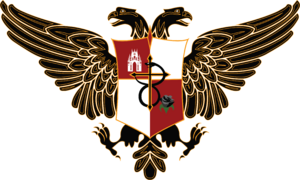
Culture
The Imperial & Federal Union in many respects lacks its own culture. Different worlds often feature different forms of culture depending on where their original colonists derived from, the history of individual member state or crownland, along with the wide variety of other factors that can effect culture. However, the Imperial & Federal Union does have three 'main' culture groups, with most individual member states and crownlands fitting in or serving as a mix of these groups. The main culture groups of the Imperial & Federal Union are Geramnic and British, as much of the Imperial & Federal Union was settled by settler from either Albion or Gerstintor. Many member state and crownlands identify very closely with one of these cultures, while others act as merging grounds between them.
With the inclusion of the Nakabe Prefecture, Japanese culture has become an effective major cultural group of the Imperial & Federal Union. However, where Germanic and British elements have spread and merged in many cases into an Anglo-Germanic mix, Japanese remains heavily contained within the Prefecture itself, with only limited mixing between the Japanese influenced areas and others.
Demographics
Holidays
Cuisine
Religion
See also: Terran Catholic Church
The most common religion of the R.u.B Union is the Imperial Terran Catholic Church.



